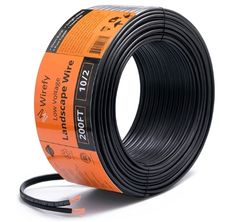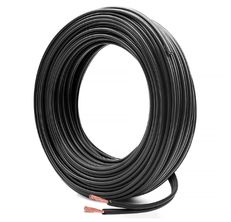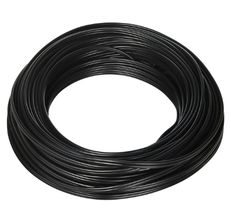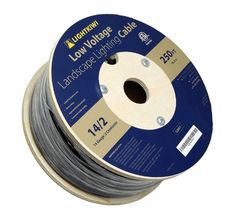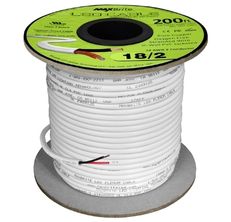The Best Low Voltage Wires to Save Energy on Your Outdoor Appliances

A dark yard is a depressing place full of squandered opportunities. Your rose bushes, walkways, trees, and even the garden fountain demand special attention. If you want to show off your outdoor space elegantly even when the sun goes down, DIY landscape lighting should be on your wishlist. While you can design a lighting system that works on conventional 120 volts from your house, a low 12 volt system is safer and more affordable for DIY installation. That’s where low voltage wires come in.
Most outdoor lighting is powered by small amounts of energy, such as patio lights, lanterns, and door openers. Low voltage cables are simple to install and safe to use because they minimize the chances of electrical fire hazards and short circuits. We’ve rated and reviewed some of the top low voltage wires of 2024 to help you choose the ideal wire for your next home improvement project.
Our Top Picks
- Best Overall: Wirefy Low Voltage Wire Shop Now ➔
- Best Value: FIRMERST Low Voltage Wire Shop Now ➔
- Most Heavy-duty: Southwire Low Voltage Wire Shop Now ➔
- Ideal for Landscaping: Lightkiwi Low Voltage Wire Shop Now ➔
- Most Flexible: MaxBrite Low Voltage Wire Shop Now ➔
What Is The Best Low Voltage Wire in 2024?
Best Overall
Light bulbs are among the most regularly used appliances that work on low power and the Wirefy Low Voltage Wire is ideal for all your outdoor lighting needs. Easy to install, this cable is a reliable option for landscaping or above ground light installation. Plus, the wire has a lifetime warranty so you can easily get a replacement if something goes wrong.
Made with a durable, heavy-duty copper coating and a flexible rubber build, you can easily cut, twist, or fold this low voltage wire. It’s thoughtfully engineered to withstand direct sunlight, abrasion, and moisture, making it ideal for direct burial. With this wire installed, you don’t have to worry about electrical hazards or short circuits thanks to its Underwriters Laboratories certification and full compliance with electrical safety standards. If you’re a beginner or a DIYer looking for a reliable option, we’ve chosen this low voltage wire as the best overall pick because of how easy it is to use and its durability.
Pros
- Flexible coating won’t tangle or tear
- Compatible with almost all outdoor lights
- Super sturdy and easy to work with
Cons
- Only compatible with lighting
Best Value
Available in lengths of 50, 100, 200, and 500 feet, the FIRMERST Low Voltage Wire caters to the needs of households as well as industrial spaces. Thanks to its amazing versatility and durability, you can use this wire to set up your doorbells, automatic door openers, and outdoor lights. It’s made using a heavy-duty material that offers much-needed flexibility to the wire, allowing you to bend, rip, or cut it without much hassle.
This low voltage wire has a weather-resistant coating, making it an ideal choice for both underground and above ground electrical connections. Plus, it won’t tangle or tear apart even under harsh weather. While it can be an eyesore for exposed indoor connections, this wire is a great choice for outdoor use and comes at an affordable price. As an added bonus, this cable can withstand temperatures of up to 140 degrees Fahrenheit without any visible signs of wear, tear, or damage.
Pros
- Complies with restrictions on hazardous substances
- Easy to recognize positive/negative wires
- Fire-proof and water-proof build
Cons
- Not ideal for indoor use
Most Heavy-duty
If you’re looking for a long-lasting and durable option, the Southwire Low Voltage Wire is the right choice for all your wiring needs. This wire simplifies the installation process, allowing you to set up lighting and other appliances on your own so you can save on labor and material costs. Because it’s made with heavy-duty, industrial-grade copper, this wire works great for both exposed and underground wiring. The copper wires are coated with a flexible vinyl coating, offering you a lifetime of use.
With this wire installed, you don’t have to worry about extended sun exposure or rain affecting the quality of the wire. You can seamlessly run it in air voids or on the walls without altering the overall aesthetics of your space. This wire boasts a tangle-free construction so you can coil it up for easy, compact storage.
Pros
- UL listed and meets safety standards
- Dust and water-resistant vinyl coating
- Durable, industrial-grade material
Cons
- Some find it hard to cut
Ideal for Landscaping
The Lightkiwi Low Voltage Wire is a versatile choice for all your outdoor wiring needs and is made to withstand moisture, sun exposure, and dust. The pure copper construction produces strong signals to supply the ideal amount of voltage to your small-scale devices and appliances. The heavy-duty coating not only protects it against wear and tear but also makes it extremely flexible for hassle-free installation. This underground wire is made to last a lifetime, offering you amazing performance to keep your appliances powered for months and even years to come.
This low voltage wire has gone through different stages of testing to ensure that you get the highest performance with unmatched reliability. Thanks to its solid construction, you don’t have to dig up wires to do repairs every few months because it won’t corrode after landscaping. Plus, the manufacturer includes a lifetime warranty, which means you can easily get a replacement if the wire stops working.
Pros
- Tested and approved for direct burial
- A durable coating offers flexibility
- 100% pure bare copper wires
Cons
- Wires may be difficult to split
Most Flexible
This high-quality low voltage wire by MaxBrite is made with 99.9% oxygen-free copper conductors to provide you with optimal current conductivity, keeping your appliances powered. It comes as an 18 gauge stranded wire with a polyvinyl chloride coating, making it extremely flexible for quick and easy installation. This cable is designed to withstand different weather conditions, so you can rest assured you’ll have a well-lit backyard or patio come rain or shine.
With its high-quality coating, this wire features amazing water resistance, keeping it safe from any type of moisture damage. Because the wire comes with a lifetime replacement warranty, you can feel secure in your purchase and replace your worn-out cables with new ones. As an added bonus, this low voltage wire remains intact even under extreme temperature fluctuations.
Pros
- UL-certified for commercial and personal use
- Available in four length choices
- Spooled for convenient storage
Cons
- Not ideal for soldering
Best Low Voltage Wires Buying Guide
Whether it’s to power lighting or communication tools, a low voltage wire is highly useful in domestic, commercial, and industrial settings because of its lower operation cost. If you aren’t sure which cable works for your needs, read this guide to find the perfect low voltage wire for your home or commercial space.
Factors To Consider When Buying Low Voltage Wires
Voltage
Always check the maximum voltage capacity of the low voltage wire you plan to purchase. Most low voltage wires are designed to carry 50 volts of electricity or less, depending on the type of wire. Most low voltage appliances need 12 volts, 24 volts, or 48 volts of current to power up, so purchasing a cable with 50 volts capacity is the safest choice.
High temperature resistance
The low voltage wire should be able to withstand high temperatures. It should work properly and carry electric current without overheating or freezing. The wire should also be able to withstand extreme weather conditions without becoming hard or losing its shape.
Diameter
When choosing a low voltage wire diameter size, experts suggest choosing a thicker wire to be on the safe side. The wire diameter affects the volume of current a low voltage wire can carry. If the wire is of a higher diameter, it can efficiently carry more current without overheating or melting. But if the diameter is on the smaller side, there are higher chances of electrical hazards. If the wire is too thin, it can even catch on fire in the case of voltage fluctuations.
What Are the Types of Low Voltage Wires?
Indoor low voltage wires
An indoor low voltage wire isn’t made to withstand the challenging environmental conditions of the outdoors. While they don’t provide the same level of insulation, they tend to have a more elegant look to match the design of your interior space. Some of these wires are even available in white that complements the majority of walls.
Installing indoor low voltage wires is very easy. Afterwards, you can charge any of your small-scale gadgets or power your lights and other appliances without raising your energy bill. When installed properly, these wires allow you to use your appliances anywhere without deviating from the aesthetic appeal of your home.
Outdoor low voltage wires
Low voltage wires used outdoors are far more durable than the ones used indoors. For lighting and other uses, they’re typically installed underground, which exposes the wires to water and humidity. Luckily, these low voltage wires are weather and water-resistant, preventing any short circuits or damage caused by moisture or fluctuating temperatures.
What Are the Benefits of Low Voltage Wires?
They make specific gadgets functional
There are several appliances that can only work at low voltage. While there are alternatives for those who don’t have low voltage wires installed, if you want to use a gadget that only operates on low voltage, you’ll have to purchase a low voltage wire at some point.
Lower long-term operating costs
Because low voltage wires use less energy, using low voltage wires ultimately costs less money in the long run. You can save this money and apply it to items you’ve been wanting to add to your house.
Enhanced safety
Low voltage wire systems are safer for houses than line voltage lighting since they use lower voltages. As a consequence, you may be eligible for lower rates on your home insurance. Make sure to ask about discounts when you speak with your agent.
More control
When it comes to home security, having complete control over all of the switches in your home allows you to turn on lights at the far end of your home if you hear a disturbing noise, such as a creaking floor or a knock on the window or door. To deter prowlers, you can quickly light up certain places in your house or yard.
Less electrical hazards
Having low voltage wiring in place can save you from scrutiny or low marks during an inspection of your home or commercial space because there is a lower chance of electrocution with these wiring systems thanks to their low voltage levels.
What Are the Materials Used To Make Low Voltage Wires?
XLPE
Cross-linked polyethylene cables, known as XLPE cables, have a 3D molecular bond structure that gives them their shape. These low voltage wires are essential in areas where wire and cable are exposed to exceptionally hot temperatures and liquids, including water and hazardous substances.
These low voltage wires have been used in many electrical applications, including plumbing and mining. The chemical, industrial, and domestic heating sectors use this material for low voltage wiring.
Polyvinyl chloride (PVC)
To make this insulating material ready to use for low voltage wiring, manufacturers apply liquids with a high boiling point to make them strong enough to withstand extreme temperatures. Polyvinyl chloride has outstanding dielectric strength, great electrical resistance, and mechanical endurance over different temperatures — it’s virtually resistant to different alkalis and acids. Due to its mechanical properties, PVC-insulated low voltage wires are often used for low voltage lighting for residential lights and electrical systems.
People Also Asked
Why do I need a low voltage wire?
The wiring in most outlets ranges from 120V to 240V. While this is useful for larger appliances that demand a higher voltage, not all items require that much power. Installing low voltage structured cabling solutions can help you avoid putting too much energy into a device. Anything less than 50 volts is considered low voltage and is a safer choice.
Can I run low voltage wires into the wall?
Absolutely! When running low voltage wires into the wall, you can bundle them together. There should be no interference between any of the signals as long as the wires are properly insulated.
How do I identify a low voltage wire?
Look for wires that transmit electricity at 50 volts or less. Most low voltage wires come in either 12V, 24V, or 48V. Low voltage wiring is different from high voltage wiring in that it uses less electricity and has different installation and use requirements.
Article Contributors
The Woodsmith Review Team’s product reviews and in-depth guides are here to help you choose the best tools and gear to build great-looking projects confidently. Woodsmith is reader-supported: When you buy through links on our site, we may earn an affiliate commission. Large language models (like Artificial Intelligence) may have been used in the research and creation of the content.
Inquiries regarding specific articles or product testing should be sent to aimperiapt@gmail.com

